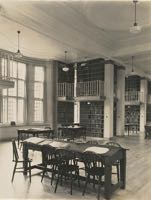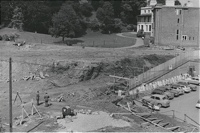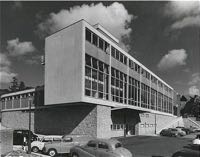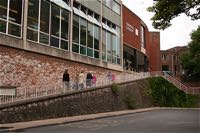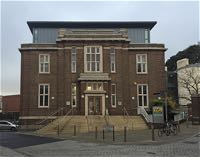
The Central Library
and Old City Library
Page added 10th December 2010
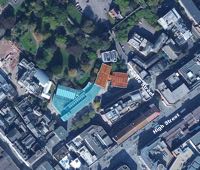 At the start of the 19th Century, the only libraries available in Exeter were subscription libraries, run by book dealers. For the gentlemen of the city, the Devon and Exeter Institution was founded in 1813, with one of its aims being a library about the arts and sciences of the west-country. However, it was not until the middle of the century that a public library for the masses was considered.
At the start of the 19th Century, the only libraries available in Exeter were subscription libraries, run by book dealers. For the gentlemen of the city, the Devon and Exeter Institution was founded in 1813, with one of its aims being a library about the arts and sciences of the west-country. However, it was not until the middle of the century that a public library for the masses was considered.
In 1850 an Act of Parliament was passed allowing local councils to hold a vote of local ratepayers with the purpose of creating a ‘voluntary tax’ to fund and run a library. To pass, the vote in favour had to exceed two-thirds of the ratepayers. A vote was held in Exeter during March 1851, at a cost of £16 10s; the two-thirds majority was not met. Although the matter was occasionally considered over the next years, Exeter remained without a public library. After the death of Prince Albert in 1861, the question of opening a museum and public library in his memory was discussed. Mr Sommers-Gard MP for the city proposed the motion for a museum, and thus, the first tentative moves toward building the Royal Albert Memorial Museum, complete with a public library were put in motion.
The museum opens
The Royal Albert Memorial Museum opened in April 1868. It was intended to provide a School of Art, Science Classes, a Museum, and Free Library, for the general public. Gradually, over the years, the museum increased its book collection, and became the place to go for students, workers, children and the general public alike. However, the library facilities were only ever an extension of the museum, and were not purpose built for a large collection.
Plans for a purpose built library
In April 1909, the Carnegie United Kingdom Trust offered the city a grant of £15,000 towards the construction costs of a new library. In 1911, the council accepted the offer from the Trustees, and announced in favour of a new library, on a site opposite the museum in Queen Street. A £2,000 grant for a library in Heavitree was added to the £15,000 for the City library in 1913. In 1917, the Governors reconsidered the whole scheme, partly because of the First War, and the high cost of construction. The City Architect, and Mr Greenslade were charged with designing the building, and the decision to move the proposed site to the garden of Rougemont House was made. Nothing happened, probably because of the war.
It wasn't until 1921, that the Governors of the museum again considered the question of a new public library. The existing facilities with the museum were becoming congested, and time was at a premium. A grant of £15,000 was still available from the Carnegie Trust, while a temporary solution to overcrowding would be to utilise the ground floor of Rougemont House. As is usual, it was agreed that a committee be formed to further consider the question of a new library.
It was not until August 1924 that the City Council approved a plan for the Governors of the Royal Albert Memorial Museum, the city architect and the city librarian to prepare plans and estimate the cost of a library, to be built in the grounds of Rougemont House. It was planned that the new facility would have a fireproof muniment room, rooms for special collections and administration.
The Portland foundation stone, bearing a carved City of Exeter coat of arms, was laid on 17 January 1928 by the Mayor, Mr Arthur Brock. The inscription stated “This Library was erected by the Council of the City and County of Exeter, with the assistance of a grant from the Carnegie Trust. Arthur Brock, Esq., M.C.., Mayor.” A second stone was laid on the opposite wall by the Chairman of the Royal Albert Museum, Mr Philip Rowsell. The builders were Messrs. Stephens and Son Ltd of Fore Street.
The new library opens
It took two and half years for the construction work to be completed on the new library. The grand opening was on Saturday 11 October 1930. Proceedings commenced with a luncheon at the Guildhall, at the invitation of the Mayor Mr H C Rowe. The Earl of Elgin was the main guest, along with various city dignitaries. The civic party left for the library at 3pm, where the Earl was given an inscribed mallet with which he knocked on the front door. The door swung open and the party walked in, and up the main staircase to the second floor where the opening speeches were made. There was then a minutes silence for those killed in the recent R101 disaster (The airship R101 crashed in France on the 5 October). The library opened to the general public the next morning.
Burnt out in 1942
The library served the city well, but disaster struck in the early hours of 5 May 1942, when the city suffered the worst raid of the war. The Control Centre was located at the City Library. The surrounding buildings were hit by incendiary bombs., and the library was completely surrounded by flames, it was abandoned at 5.29am, as fires broke out in the interior. By the end of the day the building was burnt out and about a million books and historic documents went up in smoke.
James Bell, an 11 year old boy at the time, went into the city in the late morning, looking for incendiary bomb fins. He remembered "I went inside the library and up the stairs, it was well alight. I had got in the staff entrance in Rougemont Gardens–outside there were exhausted fireman lying on the grass with there pumps still pumping water from the static water pond. I walked ankle deep through water and then up the stairs. The library staff came in while I was there to collect there personal effects–they did not take any notice of me!”
The building was burnt out, but the structure was solid, and after the war it was repaired. On 28 December 1945, a public exhibition was held in the library, of the plans for rebuilding Exeter after the war. Drawn up by Mr Thomas Sharp, the Exeter Phoenix plan, as it became known by, was on for two weeks. The city was given a grant of £40,000 for the purchase of new books for the library in March 1946, although the repaired library was not large enough to store the new stock.
Through the 1950s the old library premises housed the Devon Records Office. It was obvious that despite the building being only 30 years old, it was no longer large enough for a growing city. Plans were put in place, and a new library was built, at the rear of the old library, in 1965. The old library building housed the records office and the Westcountry Studies Library. Eventually they both moved out, and the building became the city Registry Office in the early 2000s.
When Devon County Council sold Exeter Airport in 2007, they promised that the city would get a new Central Library. In the event, the 1960s library was closed and a major refurbishment made. It re-opened in May 2014. The old City Library was sold, and the Registry Office closed in 2010. The first and second floors were refurbished, along with a new third floor added on the roof, for 44 student flats. The ground floor has been rented to Wilkinson Grant and Co, a firm of solicitors. The refurbished Central Library reopened in May 2014.
Sources: The British Newspaper Archive, the Express and Echo, James Bell and Exeter Burning by Peter Thomas.
│ Top of Page │

